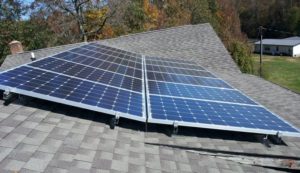 In our last post we talked about some of the variables that would go into a business case or business model for your assessment of whether it makes sense for you financially to install a solar panel system on the roof of your home. One of those variables, a big one, is of course the revenue you will gain from this type of installation.
In our last post we talked about some of the variables that would go into a business case or business model for your assessment of whether it makes sense for you financially to install a solar panel system on the roof of your home. One of those variables, a big one, is of course the revenue you will gain from this type of installation.
It may be net revenue or it can also be cost of electricity not used that you would need to factor into your calculations. Either way you need to understand how much electricity can be produced from your roof. This is where it gets complicated, because you really need a solar site assessment to be able to calculate the theoretical value of this income.
Some companies will charge for the solar site assessment and then write it off if you decide to go ahead with a solar panel installation. It is all in what you negotiate, so have that discussion up front so that there is no misunderstanding once the assessment is completed.
Information needed to Complete a Solar Site Assessment for Your Home
The following list is pretty straightforward and should be included in your assessment if it is completed in a professional manner. This is something that you need to make sure that you receive from a professional company and that it is done right. If they estimate high in terms of the amount of electricity generated, then your business plan may not pay off as expected. Take your time to understand all of the assumptions and confirm all of the estimates before you take the plunge.
- Which roof or roofs will be candidates for solar panels
- Azimuth of each roof
- Pitch of each roof
- Number of panels
- Wattage of each panel
- Inverter make , model, and efficiency rating
- Shading on the roof from External Factors
Which roof or roofs will be candidates for solar panels?
Typically, east, south and western roofs will be included in your assessment. Northern facing roofs will generate electricity, however since most are not receiving direct sun unless you are very far south, it is just not worth it to include a norther roof in your solar assessment.
Azimuth of each roof?
The azimuth is the angle between the north point and the direction your roof is facing. This is the accurate measurement of the direction each roof is facing and will be a factor in calculating the efficiency factor associated with each roof..
Pitch of each roof?
The pitch of each roof is the angle from the horizontal and also plays a part in the calculation of the efficiency factor of each roofs as well.
Number of panels?
The number of panels is a combination of the area of your roof as well as the ability of your roof to support the additional weight. Each panel will produce a specific amount of electricity depending on the Azimuth, the Pitch, the time of day and the season.
Wattage of each panel?
Each panel has a wattage that it is capable of producing. Different solar panels will have a different wattage rating or power that they will produce.
Inverter make , model, and efficiency rating?
Each solar panel is connected to an inverter. Which converts the electricity generated to the desired voltage and amperage level required to interconnect with all other panels. Also the electrical distribution system. Depending on the manufacturer, each will have their own efficiency rating as well.
Shading on the roof from External Factors?
This can be a huge issue and may vary depending on the time of year. Shading from surrounding trees will change from season to season as the leaves grow and fall from the tree. Other buildings or obstructions on the roof such as a chimney can also provide shade. Which decreases the amount of power that will be generated. Decisions may have to be made in terms of trimming trees or locating panels only were there is no shade. Shading can be different in the morning vs. afternoon so time of day must also be taken into account.
All of these factors should be assessed in your solar assessment. These are mathematical calculations which can be generated by a computer model. We would recommend that some sensitivity analysis be completed on the results. Assess the impact more or less solar power generated will have on your budget and payback.
Consumers have to remember that sales people are motivated to sell you a solar system. They will more often than not make assumptions in their favor. It pays to take as much as 20% off the estimate of electricity generated to see what impact it has on the business case for your system.
More to come on alternative energies and solar systems. If you have added comments or opinions please leave us a comment. We are trying to learn as much as possible about this subject. For more help with solar power assessments, click here.
July 2nd, 2012 on 5:58 pm
This is a really good informational post about a solar system assessment for a persons home. This is one of the best web sites I have found yet about this subject